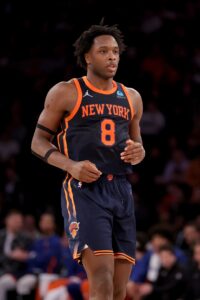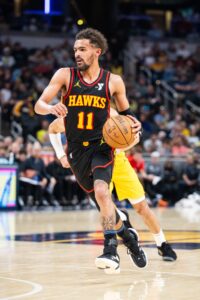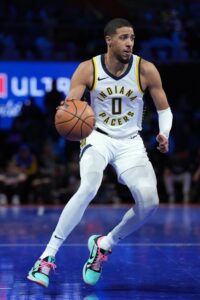Hoops Rumors is checking in on the 2024 offseason for all 30 NBA teams, recapping the summer’s free agent signings, trades, draft picks, departures, and more. We’ll take a look at each team’s offseason moves and consider what might still be coming before the regular season begins. Today, we’re focusing on the New York Knicks.
Free agent signings
 OG Anunoby: Five years, $212,500,000. Fifth-year player option. Includes 15% trade kicker. Re-signed using Bird rights.
OG Anunoby: Five years, $212,500,000. Fifth-year player option. Includes 15% trade kicker. Re-signed using Bird rights.- Precious Achiuwa: One year, $6,000,000. Re-signed using Bird rights. Waived right to veto trade.
- Cameron Payne: One year, minimum salary. Signed using minimum salary exception.
- Chuma Okeke: One year, minimum salary. Non-guaranteed (Exhibit 10). Signed using minimum salary exception.
Trades
- Acquired the draft rights to Dillon Jones (No. 26 pick) and the No. 51 pick in the 2024 draft from the Wizards in exchange for the draft rights to Kyshawn George (No. 24 pick).
- Acquired either the Celtics’ or Grizzlies’ 2025 second-round pick (whichever is more favorable); the Warriors’ 2026 second-round pick; the Timberwolves’ 2027 second-round pick; either the Thunder’s, Rockets’, Heat’s, or Pacers’ 2027 second-round pick (whichever is second-most favorable), and either the Thunder’s, Rockets’, Heat’s, or Pacers’ 2027 second-round pick (whichever is third-most favorable) from the Thunder in exchange for the draft rights to Dillon Jones (No. 26 pick).
- Acquired the draft rights to Tyler Kolek (No. 34 pick) from the Trail Blazers in exchange for the Timberwolves’ 2027 second-round pick; either the Pacers’ or Wizards’ 2029 second-round pick (whichever is least favorable); and the Knicks’ 2030 second-round pick.
- Acquired the draft rights to Ariel Hukporti (No. 58 pick), the draft rights to Petteri Koponen, and cash ($1MM) from the Mavericks in exchange for the draft rights to Melvin Ajinca (No. 51 pick).
- Acquired the draft rights to Oso Ighodaro (No. 40 pick) and cash ($500K) from the Thunder in exchange for the draft rights to Ajay Mitchell (No. 38 pick).
- Acquired the draft rights to Kevin McCullar (No. 56 pick) and the Celtics’ 2028 second-round pick (top-45 protected) from the Suns in exchange for the draft rights to Oso Ighodaro (No. 40 pick).
- Acquired Mikal Bridges, Keita Bates-Diop, the draft rights to Juan Pablo Vaulet, and either the Pistons’, Bucks’, or Magic’s 2026 second-round pick (whichever is least favorable) from the Nets in exchange for Bojan Bogdanovic, Shake Milton (sign-and-trade), Mamadi Diakite, the Knicks’ 2025 first-round pick, the Bucks’ 2025 first-round pick (top-four protected), the Knicks’ 2027 first-round pick, the Knicks’ 2029 first-round pick, the Knicks’ 2031 first-round pick, the right to swap a 2028 first-round pick (the Nets’ or the Suns’; whichever is most favorable) for the Knicks’ 2028 first-round pick, and the Nets’ 2025 second-round pick.
Draft picks
- 1-25: Pacome Dadiet
- Signed to rookie scale contract (four years, $13,012,968).
- 2-34: Tyler Kolek
- Signed to four-year, $9,062,682 contract. First three years guaranteed. Fourth-year team option.
- 2-56: Kevin McCullar
- Signed to two-way contract.
- 2-58: Ariel Hukporti
- Signed to two-way contract.
Two-way signings
Departed/unsigned free agents
Other moves
- Signed Jalen Brunson to a three-year, $156,549,124 veteran extension that begins in 2025/26. Includes fourth-year player option and 15% trade kicker.
- Exercised Jericho Sims‘ 2024/25 team option ($2,092,344).
Salary cap situation
- Operating over the cap ($140.6MM), over the luxury tax line ($170.8MM), and between the first tax apron ($178.1MM) and second tax apron ($188.9MM).
- Carrying approximately $179.2MM in salary.
- Hard-capped at $188,931,000.
- Taxpayer mid-level exception ($5.2MM) available.
- Two traded player exceptions frozen/unavailable (largest worth $5,241,072).
The offseason so far
Considered a potential landing spot for top free agents and trade candidates for several seasons, the Knicks managed to climb up the Eastern Conference standings in recent years without ever swinging a major deal for a star.
Their biggest free agent addition during that time, Jalen Brunson, has evolved into an All-NBA player in New York, but that was far from a given when he signed in 2022 — to that point, he only had one season as a full-time starter under his belt and had posted a career average of 11.9 points per game. The Knicks’ biggest trade during that same time period, made midway through the 2023/24 season for OG Anunoby, didn’t involve a single outgoing first-round pick.
If not for injuries to key players like Anunoby, Julius Randle, and Mitchell Robinson, among others, the Knicks had a real shot to advance to the Eastern Conference Finals in 2024. They nearly made it anyway, taking the Pacers to seven games in the Eastern Semifinals after winning 50 regular season games for just the second time since 2000.
With the club on the verge of title contention, the time was right this offseason for the Knicks to finally take their big swing and cash in some of those first-round picks they’d been hoarding. They struck a deal with the Nets to acquire Mikal Bridges in exchange for a package that featured four unprotected first-round picks, a fifth lightly protected first-rounder, and a first-round pick swap.
 It was a stunning move for multiple reasons. For one, the Knicks and Nets are unlikely trade partners — the two New York clubs hadn’t made a deal with one another since 1983.
It was a stunning move for multiple reasons. For one, the Knicks and Nets are unlikely trade partners — the two New York clubs hadn’t made a deal with one another since 1983.
Bridges wasn’t widely considered to be available, since the Nets didn’t control their 2025 or 2026 first-round selections and appeared more inclined to build around the forward than to bottom out to increase the value of lottery picks they didn’t own. But at the same time they sent Bridges to New York, the Nets reached a separate agreement with Houston to regain control of their ’25 and ’26 picks, setting them up to rebuild in earnest over the next year or two.
It was also a substantial price to pay for a player who has never made an All-Star team or won a major NBA award. The price wasn’t far off from the one Minnesota paid for Rudy Gobert in 2022 — that package included more useful veterans (Jarred Vanderbilt, Malik Beasley, Patrick Beverley) than what the Knicks gave up (Bojan Bogdanovic, Shake Milton), but the draft-pick compensation the Jazz received (three unprotected first-round picks, one lightly protected first-rounder, the rights to No. 22 pick Walker Kessler, and a first-round swap) was nearly identical.
Although the Bridges acquisition was a surprising one, it made perfect sense for the Knicks in many respects. Most of the other trade candidates linked to New York in recent years – such as Donovan Mitchell and Karl-Anthony Towns – were big-time scorers who wouldn’t help much on defense, making them questionable fits on a roster coached by Tom Thibodeau. Bridges, on the other hand, is a two-way force who has hovered around 20 points per game for the past two seasons, has knocked down 37.5% of his career three-point attempts, and finished second in Defensive Player of the Year voting in 2022.
Acquiring Bridges also allowed the Knicks to add to their set of Villanova alumni — like new teammates Brunson, Josh Hart, and Donte DiVincenzo, Bridges played for the Wildcats from 2015-17. All four players were on the 2016 championship roster, while Brunson, DiVincenzo, and Bridges won a second national title in 2018. Whether that Villanova connection actually improves the Knicks’ title odds is up for debate, but having a group of long-time friends who genuinely like each other certainly helped create good vibes in New York last season. Bridges’ arrival should only help in that regard.
As steep a price as the Knicks paid to acquire Bridges, the team hasn’t yet fully exhausted its cache of draft assets, so another smaller move or two isn’t out of the question. Plus, if they were going to splurge on anyone, it makes sense for the Knicks to do so on a player on a team-friendly contract who comes with little to no fit concerns.
After agreeing to trade for Bridges, New York re-signed his new partner on the wing, Anunoby, to an eye-popping five-year, $212.5MM contract. The move gives the Knicks two of the NBA’s top three-and-D players, putting them in a great position to match up with a defending-champion Celtics team led by Jayson Tatum and Jaylen Brown.
It’s a high price to pay for an oft-injured player like Anunoby, who has missed 29, 34, 15, and 32 games in the past four regular seasons and was hurt again in the second round of the playoffs. His impact, which goes far beyond his scoring output, is so significant that if he manages to play 65-70 games per season for the next few years, the investment will be worthwhile, but it’s a risky one.
The fact that the Knicks were able to lock up Brunson to a below-market contract extension (four years, $156.5MM) on the heels of his fifth-place finish in MVP voting helps offset the high price the club paid to retain Anunoby. Both players are now under contract through at least 2027/28, with player options for ’28/29, and while Anunoby will earn higher salaries than Brunson for the next four years, the overall price the club will pay for the duo is a reasonable one.
While Brunson was the only Knicks player to receive an extension this summer, the team also completed a new long-term deal with Thibodeau, who was set to enter the final year of his existing contract. Thibodeau has his share of critics who argue his tendency to lean too heavily on certain players leads to injuries, but it’d be hard to claim he hasn’t gotten the most out of his rosters during the past couple years, deftly navigating those injury issues to keep the Knicks competitive.
The Knicks also made several minor moves in the draft and free agency to fill out their roster, re-signing Precious Achiuwa, adding Cameron Payne, and drafting Pacome Dadiet and Tyler Kolek.
It wasn’t all good news in New York though, as the club’s spending limitations prevented a new deal with Isaiah Hartenstein, the backup center who became the starter for much of the season due to Robinson’s health problems.
Because they only held Hartenstein’s Early Bird rights, the Knicks were limited to offering approximately $72.5MM for four years, and not quite all of that money would’ve been guaranteed. New York put its best offer on the table, but the Thunder topped it with a three-year, $87MM bid that included nearly $60MM in guaranteed money over the first two seasons. The Knicks’ offer included only about $30MM in guaranteed salary during those same two years.
It’s a significant loss for the Knicks, who benefited greatly from Hartenstein’s defensive versatility and rim-protecting ability, as well as his screening and play-making on offense. Robinson is a very good rim-runner and defender who is more athletic than Hartenstein, but he has dealt with injuries in recent years and isn’t the type of player who can be relied upon for 30 to 35 minutes per night (his career high is 27.5 MPG). His offensive game is somewhat limited too, as he’s not much of a shooter or passer.
Achiuwa, Randle, and Jericho Sims will soak up some minutes at center during the regular season, and the Knicks can probably get by with those options for a while, but it’s safe to assume the team will remain on the lookout for a more reliable and more traditional backup center after failing to land one this offseason.
Up next
As detailed above, the hunt for a backup center figures to continue into the fall — and potentially well into the regular season if no good options materialize in the next month-and-a-half.
Although New York still has its full taxpayer mid-level exception ($5.2MM) available, there are no free agent centers still on the market who warrant more than minimum-salary investments, so barring a surprise preseason cut, a trade will likely be necessary to address the position. The Knicks can freely aggregate players’ contracts in a trade, but can’t take back more salary than they send out.
The Knicks have an open spot on their projected 15-man regular season roster, but may keep it open to maximize their flexibility. That would line them up to bring in a 15th man later if one of their two-way players emerges, injuries necessitate an acquisition at a specific position, or they simply want to add more depth.
Randle isn’t the only extension-eligible player on the roster (Robinson or Sims are also in that group), but he’s certainly the most noteworthy one. He holds a player option for the 2025/26 season, giving him an opportunity to reach unrestricted free agency next July.
Obviously the Knicks won’t want to lose Randle for nothing, but it wouldn’t surprise me if they take extension talks into the season and wait to see how the three-time All-Star looks coming off shoulder surgery as part of the new-look rotation. He could sign a new contract at any time until June 30 as long as he declines his player option as part of the deal (up until October 21, he could exercise the option as part of an extension), so there should be no rush from the team’s perspective.

 It was a stunning move for multiple reasons. For one, the Knicks and Nets are unlikely trade partners — the two New York clubs hadn’t made a deal with one another since 1983.
It was a stunning move for multiple reasons. For one, the Knicks and Nets are unlikely trade partners — the two New York clubs hadn’t made a deal with one another since 1983.
 The first of those two moves was a trade that sent former lottery pick
The first of those two moves was a trade that sent former lottery pick 
 2024/25:
2024/25:  2024/25:
2024/25: